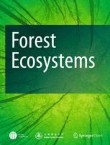Litterfall dynamics and soil carbon and nitrogen stocks in the Brazilian palm swamp ecosystems
This study aimed to determine the litterfall production, accumulation, decomposition rate and nutrient stocks, and to estimate the soil carbon (C) and nitrogen (N) stocks in three palm swamp ecosystems with di...
